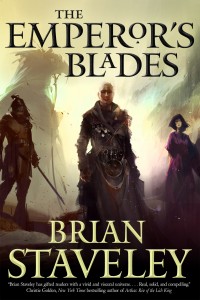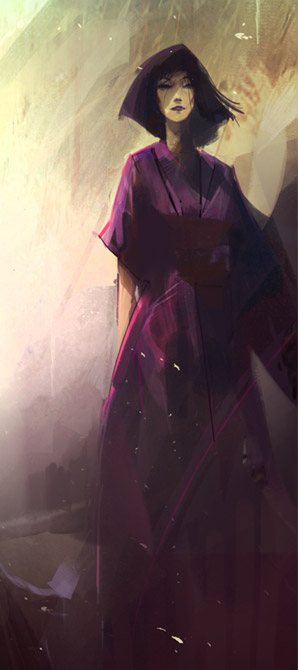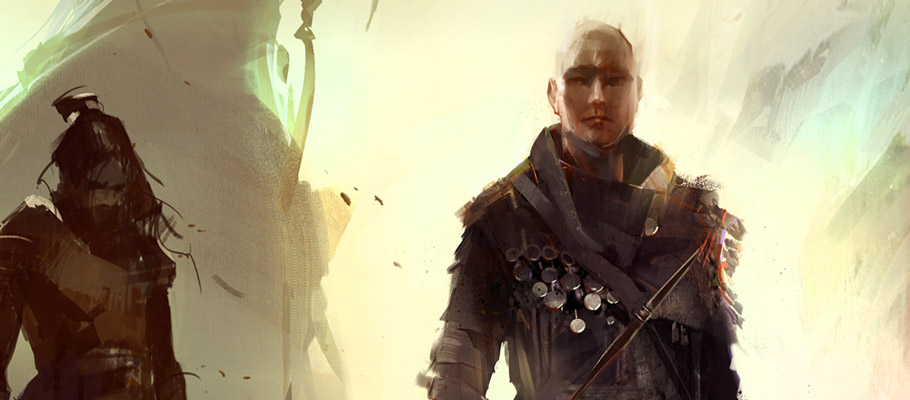
As epic fantasies so often do The Emperor’s Blades, a debut novel from Brian Stavely, begins with the death of a ruler, and continues to follow the fall-out as it consumes his realm and children. This pattern should be familiar to readers of everything from George R.R. Martin’s A Song of Ice and Fire, to David Anthony Durham’s Acacia Trilogy. In this case, Staveley begins with three children — two male heirs, Kaden and Valyn, and a daughter suited to rule in all ways but her gender, Adare. The boys are gone from court, sent away by their father to learn at the feet of other masters, both to groom them for rule and protect them from the court’s conspiracies. Kaden, first in line for the throne, is a monk. Not the sexy D&D-type, with fists of stone, but rather a contemplative ascetic seeking to understand the world from a different perspective. Valyn lives a different life among the Kettral, the Empire’s special forces. Most of the Staveley’s narrative is concerned with the brothers’ conflicts: Kaden to realize a state of mind his father sent him to learn, and Valyn to find acceptance in an elite brotherhood. Of course, the impact of their father’s death resonates throughout their stories, but only in an overarching way. The Emperor’s Blades is very much a coming of age story, and less about the epic struggle for the Unhewn Throne and the fate of the world.

It’s a complaint that can be lodged against the entire novel: Staveley telling the reader one thing, showing another, and ultimately providing a climax supported by neither.
It’s no coincidence that I haven’t mentioned the third sibling yet. Adare, daughter and eldest child of the dead emperor, is given only a fraction of the page time that her brothers receive. Conferred as Minister of Finance on her father’s death, Adare finds herself in the middle of a political firestorm as her father’s assassin seeks absolution in his faith. Among the three points of view, hers is most significant in relation to the overall arc of the coming epic confrontation. She is on the front lines of what will become the series’ focus once Kaden and Valyn resolve their own personal struggles to become the men their father wished them to be. Sadly, Adare’s capability is often impeached by committing impetuous and, occasionally, stupid acts for seemingly no other reason than furthering Staveley’s plot. It’s a complaint that can be lodged against the entire novel: Staveley telling the reader one thing, showing another, and ultimately providing a climax supported by neither. I don’t want to delve too deeply into this, as it would be rife with spoilers, but suffice to say, there are many conveniences in the story that lighten the author’s construction load. The result is a brisker but less satisfying narrative than similar epic fantasies.
Like Brandon Sanderson in Mistborn, or Patrick Rothfuss in Name of the Wind, Staveley’s work has the capacity to indulge reader speculation.
Putting these criticisms aside for a moment, as I’m willing to attribute them to debut author pitfalls, The Emperor’s Blades is mostly thrilling. It has interesting characters, (even if the most interesting of them is given short shrift, but I digress), and a magic system that invites reader investment. It’s the latter that may elevate Staveley’s novel above the sea of sameness. Like Brandon Sanderson in Mistborn, or Patrick Rothfuss in Name of the Wind, Staveley’s work has the capacity to indulge reader speculation.
In the World of Warcraft community, it’s called theory-crafting: the mathematical analysis of game mechanics to discover the best strategies and tactics to maximize player effectiveness. With this in mind, I’ve noticed that many of the most successful epic fantasies indulge their own form of theory-crafting. All of the aforementioned work of Rothfuss and Sanderson, Robert Jordan’s Wheel of Time, and Peter V. Brett’s Demon Cycle all invite the reader to speculate about the best configuration of the magic system. How would the world react if I did X, or Y, or X+Y? The Emperor’s Blade attempts the same trick, but twists it slightly by creating a magic system is simple in mechanics, but complex in its plot implications.

Without knowing the source of a leech’s power, the reader [becomes] a participant in the deduction, not merely a spectator, and it works fantastically well.
Magic is scorned and persecuted in Staveley’s world, not unlike the Salem witch trials in our own. Leeches, as the magic users in The Emperor’s Blades are known, can warp reality by pulling from their well, a random and unknown source of power that’s unique to each magic user. A well could be something as rare as diamond, as pervasive as sunlight, or as esoteric as love. Without knowing the source of a leech’s power, the reader is forced to look for clues, to deduct through the text how they gain their power, and how they might apply it against the various conflicts, large and small, within the novel’s plot. Although it isn’t quite as engaging as, say, the physical consistency of Sanderson’s Allomancy, Staveley’s magic system has a deep-seated charm all its own. The reader becomes a participant in the deduction, not merely a spectator, and it works fantastically well.
The Emperor’s Blades has a great deal to speak in its favor, and I enjoyed my time with it. Though the novel falls into several plot and character holes that invite the proverbial truck to drive through, Staveley impresses by immersing the reader in his rich world building, providing unconventional situations for conventional characters, and pulling it all together in a structure comfortable for genre fans. What it doesn’t do, however, is anything new. Brian Staveley’s debut is not the next big thing, but another solid addition to the last big thing – another epic fantasy trying to fill the Wheel of Time sized hole in your heart.


“Brian Staveley’s debut is not the next big thing, but another solid addition to the last big thing – another epic fantasy trying to fill the Wheel of Time sized hole in your heart.”
Quote of the review right there. I’m not always looking to read the next big thing—sometimes it’s comforting to slip back into the tropey Fantasy world that got us all hooked on the genre.
I’m currently not in the market for yet another unfinished epic fantasy series to add to my reading list, but I just wanted to say: that cover is absolutely stunning.
The cover is awesome. It’s funny – I love but don’t read much epic fantasy, and as a result, a mixed review for me might as well be a bad one. That said, I can be drawn in by a second book in a series that gets really good reviews, so the game’s not over yet, as it were.
Kevin & Steven — The cover is by Richard Anderson, who’s also the artist behind the recently revealed cover for The Mirror Empire by Kameron Hurley. He’s one of my favourites!
I think I’m going to be upset by the lack of screen time the daughter receives and some of those pitfalls might indeed turn me off but I’m still hoping to read this one in the coming weeks.
Great review as always Aidan. This one is going on my watch list for the day the series completes.
This book was a pleasant page turner, that kept me hooked from page one. Staveley is a good wordsmith–not the best, but he has better command of the English language than most writers of fantasy fiction. I learned half a dozen new words reading his prose, but he still writes in a fluid style that makes the novel enjoyable to read.
His magic system is decently original, but it isn’t the emotional heart of the book. Staveley doesn’t make the reader feel the emotions of the magic users nor delve into their sensations when using magic, which is unusual for fantasy writers.
What is original is Staveley’s examination of selflessness and the pedogogy of the Shin monks, which is draws from Buddist teaching about the abandonment of the ego. The book is about coming of age for each of the three siblings, where each becomes more than their training, but also discovers that they have violated the ethical system in some way. To survive and vanquish their foes, the sister Adare has to go beyond legalism and rule of law; the heir Kaden has to overcome the self agrandizement inherent in being emperor, but he also has to abandon the pacifism of a monk; and Valyn has to violate the role of honor-bound knight and embrace the darkness of being a vengeful killer. In other words, the protagonists become filled with more shades of gray as the book progresses, as their morals are challanged and often traversed.
The chief failing in my opinion, which is a common failing of most fantasy fiction, is that the morality and emotional conflict of the antagonists is never explored. While the good guys become less “good”, the bad guys stay cookie-cutter foils. It is hard to understand the motivations of the Kestrals and religious faction who ally with the Csestriim. The conflict between church and state could have been a very interesting motif of the book, but Staveley never fleshed it out. Staveley should have explored the feelings and motivations of the Kestrals who betray of their years of training as protectors of the empire. The only antagonists whose motivation is credible are the Csestriim, but their inherent inhumanity makes it impossible to explore their motivation on an emotional level. In other words, evil is evil because it is unexplanable and unexplorable.
In history all actors, even the ones who are labeled as evil, justify to themselves why their actions are necessary and even “good”. They may want power, money, prestige, etc., but they also have ideas why what they are doing is “right”. The Nazis killed 11 million jews, communists, slavs, homosexuals and gypsies in the name of creating a racially pure society and avenging the past humilliation of the German people in WWI. Stalin killed 3.5 million in the great purges in the name of protecting the Communist state from internal enemies, that threatened to undermine the revolution. The US government killed 3.5 million people in Indo-China in the name of anti-Communism, killed half a million Iraqi children by embargoing Iraq between the Gulf Wars and lied to the American people in order to initiate many wars in 1846, 1898, 1917, 1964 and 2003. Evil is frankly boring, until it begins to try to justify its own actions, and that is where I think that The Emperor’s Blades fails most.
Sadly, Staveley has set up the principal antagonists, the Csestriim, to be inherently inhuman and incapable of feeling human emotion, so they can never be fleshed out on emotional terms, but I hope that future volumes in this trilogy will at least flesh out their motivations on intellectual terms, so that we can better grasp them as antagonists. Likewise, the motivations of the remaining human antagonists Balendin and Ran should be explored to improve the remaining volumns in the series.